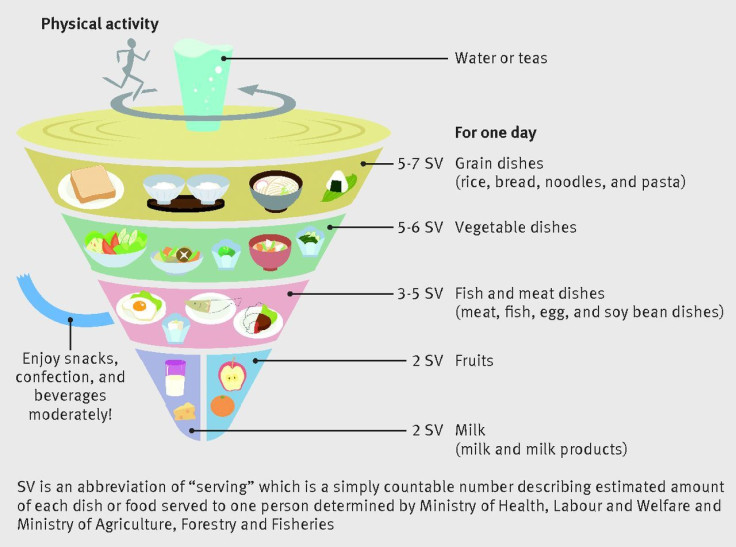Japanese Diet Filled High In Grains, Vegetables, And Fish May Lower Heart Disease Risk

Whether it’s good genes or a healthy lifestyle, there must be something behind the longevity trend throughout Japan. For quite some time, Japan has ranked as one of the top countries for the longest life expectancy — Japanese women in particular, who in 2012 were listed as having the longest life expectancy of anyone in the world, with an average age of 87.
In a new study, researchers attempt to understand how the Japanese diet plays a role in longevity, and how it may decrease risk of certain chronic diseases like cardiovascular disease. They found that balanced meals of grains, vegetables, fruits, fish, and meat contributed to a decrease in the risk of death and cardiovascular disease. They used the Japanese Food Guide Spinning Top (pictured below) as a standard of a healthy, balanced diet, and had participants complete surveys about how much they adhered to it. Then they compared the results to mortality rates. The Spinning Top was created in 2005 by the Japanese Ministry of Education, Science, and Culture, the Ministry of Health and Welfare, and the Ministry of Agriculture, Forestry, and Fisheries to help people eat healthier, more balanced meals. The researchers examined data from 36,624 men and 42,920 women between the ages of 45 and 75, and kept track of them for 15 years.

In each survey, the researchers gathered information about the participants’ medical histories, as well as their lifestyles and habits like smoking, drinking, and diets. For the diet survey, the participants reported how frequently they consumed 147 different food and beverage items — placed into the main categories of the food guide, including grain dishes, like rice, bread, and noodles; vegetables, like mushrooms, potatoes, and seaweed; and fish and meat, including eggs, soybeans, and milk. They also reported how big their portions typically were. The answers to these questions resulted in a score based on how much they adhered to the Japanese food guide, with a higher score indicating better adherence.
Both men and women who had higher scores of adherence to the Japanese food guide ended up having a 15 percent lower total mortality rate over the course of 15 years. As the researchers also analyzed cause of mortality, they posited that a reduction in cardiovascular disease among the healthy eaters played a significant role in reducing mortality risk.
“Our findings suggest that balanced consumption of energy, grains, vegetables, fruits, meat, fish, eggs, soy products, dairy products, confectionaries, and alcoholic beverages can contribute to longevity by decreasing the risk of death, predominantly from cardiovascular disease, in the Japanese population,” the authors wrote.
For the American population, which is far more likely to consume lots of calories from processed foods, learning more about balanced diets may be key to maintaining a healthy lifestyle well into old age.
Source: Kurotani K, Akter S, Kashino I, Goto A, Mizoue T, Noda M. Quality of diet and mortality among Japanese men and women: Japan Public Health Center based prospective study. BMJ. 2016.
Published by Medicaldaily.com



























